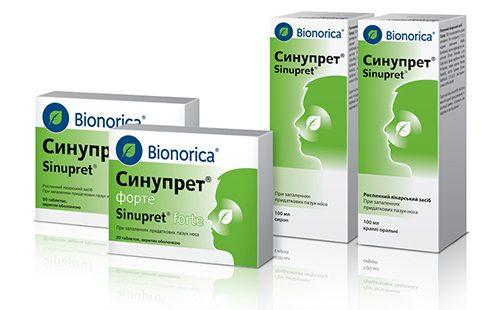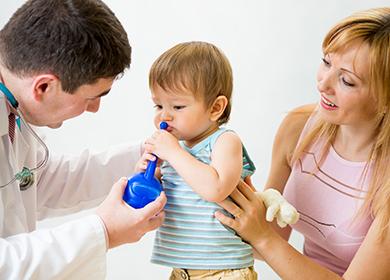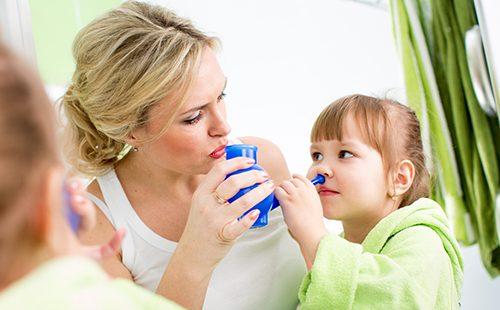The content of the article
Inflammation of the sinuses is a fairly common occurrence in pediatric patients. In the last decade, there has been a progressive increase in the frequency of this disease. Catarrhal forms of sinusitis are most often diagnosed when there are no signs of suppuration in the sinuses. Somewhat less, it is a purulent nature of the inflammation.
So what if the child has severe sinusitis? How much is he treated? How can it be cured?
How does the disease develop?
Most often, this pathology occurs against the background of an acute respiratory viral infection. Typically, pathogens of inflammatory changes in the mucosa are:
- adenoviruses;
- rhinoviruses;
- parainfluenza viruses;
- influenza viruses.
The role of pathogenic bacteria
In some cases, a child's sinusitis can be complicated by the addition of secondary bacterial inflammation. It occurs when the immunity is weakened, when the bacterial flora rapidly multiplies on the nasal mucosa.
In most cases, purulent sinusitis are caused by the following pathogens:
- streptococci;
- staphylococci;
- hemophilic bacillus.
Promotes the development of bacterial sinusitis and swelling of the nasal mucosa, which leads to the closure of the lumen connecting the nasal passages and sinus. This, in turn, provokes an insufficient supply of oxygen to the sinus and a decrease in the activity of the ciliary epithelium of its mucous membrane. Such processes contribute to the accumulation of discharge, its suppuration, thickening of the sinus walls, and the appearance of a characteristic picture of sinusitis.
Symptoms of sinusitis in children
All manifestations of sinusitis can be divided into two large groups:
- general symptoms;
- local symptoms.
Common symptoms usually indicate a viral or bacterial infection in the body. The child is worried about:
- general weakness;
- headache;
- muscle soreness;
- fever.
Characteristic local symptoms
Local symptoms of sinusitis in children include:
- swelling of the mucous membrane, which is felt as a stuffy nose;
- discharge from the nose of a mucous or purulent character;
- swelling of the soft tissues of the face in the sinus;
- pain in the projection of the affected sinuses.
How is pathology diagnosed?
Sinusitis in children is diagnosed by analyzing complaints, as well as objective examination data. During the admission, the ENT doctor performs rhinoscopy, that is, an examination of the nasal cavity. Today, endoscopy of the nasopharynx is increasingly used for this purpose. With sinusitis during this examination, it is determined:
- mucous or purulent discharge in the nasal passages;
- "Leakage" of pus or mucus from the causal sinus;
- swelling, redness of the nasal mucosa and mouth of the affected sinuses.
If there are indications, additional non-invasive diagnostic methods can be additionally prescribed:
- X-ray of the sinuses;
- ultrasound scan of the sinus;
- computed tomography of the sinuses.
In pediatrics, computed tomography is performed only according to strict indications, which is caused by exposure during the study of x-ray radiation. An alternative would be an MRI of the sinuses. Additionally, a general clinical blood test is also prescribed, in which an increase in the number of leukocytes and an acceleration of ESR indicates a bacterial inflammatory process.
Therapy for inflammation of the sinuses
The treatment of sinusitis, first of all, pursues the following goals:
- restoration of the lumen of the anastomoses connecting the sinus and nasal cavity;
- liquefaction and improvement of the outflow of the separated sinuses;
- fight against the causative agent of infection.
To achieve a therapeutic effect, the following groups of drugs are used.
Decongestants
These are drops that reduce swelling of the nose and restore patency of the anastomoses of the sinuses. For example:
- "Nazivin";
- "Vibrocil";
- Galazolin.
Antibacterial agents
Antibiotics are indicated for the bacterial nature of the disease. Usually, doctors use drugs with a wide spectrum of action and proven effectiveness in sinusitis (Amoxicav, cephalosporin drugs).

Mucolytics
These are sputum thinners. They improve fluidity and reduce the viscosity of the discharge, restore drainage from the sinuses. Most often, these drugs include acetylcysteine.
Herbal preparations occupy a special place in the treatment of sinusitis. Among the latter, "Sinupret" is most often prescribed - a medicine containing a complex of plant extracts. The main components of the drug are:
- gentian root;
- sorrel grass;
- primrose flowers;
- black elderberry flowers;
- verbena grass.
Each of these plants has valuable healing properties and enhances the action of other components of the drug.
"Sinupret" is available in the form of drops for oral administration and dragees. For young children, the use of a liquid form is recommended. Starting from six years you can give dragees. The drug has a multidirectional effect in sinusitis:
- reduces mucosal edema by reducing vascular permeability;
- dilutes the inflammatory secretion in the sinuses;
- activates the activity of the ciliary epithelium;
- has an immunomodulatory effect.
In the acute form of sinusitis, the medicine is taken for about 7-14 days, but if necessary, its administration can be extended up to three weeks. In clinical trials, the effectiveness of this drug in catarrhal forms of sinusitis was proved. And with simultaneous administration with antibiotics, Sinupret enhances their effect. According to the opinions of doctors and patients, the medicine contributes to the more rapid disappearance of the symptoms of sinusitis, speeds up the recovery time and significantly reduces the risk of complications.
Thus, the treatment of sinusitis in children requires the appointment of a whole range of drugs. Therefore, even the slightest signs of inflammation in the paranasal sinuses should become a reason for seeking medical help. Doctor's recommendations are especially important at high temperature, the presence of signs of intoxication, purulent discharge from the nose. After all, only a medical specialist will be able to objectively assess the clinical situation and draw up the most effective treatment regimen.


